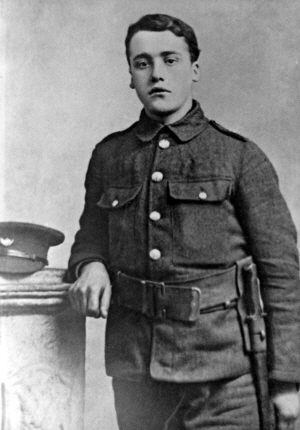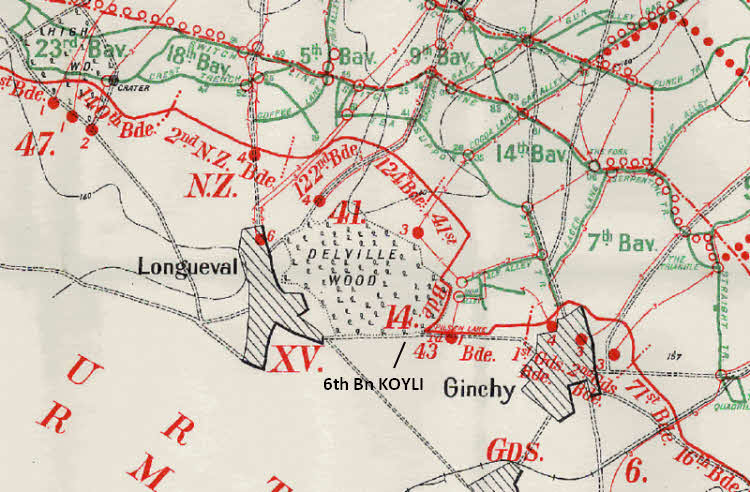
Willie Dews was born in Gildersome, Morley in 1897, the son of Ethelred Dews and Ellen (nee Peace) who were married in 1893 in the Dewsbury Registration District, probably at Ossett. Ethelred was the brother of Ernest Dews who was killed in action during WW1. The Dews family were living in Horbury Road, Ossett in 1901. By 1911, Willie is working as a butcher’s errand boy and living with his parents and four siblings at 1, King Street, Station Road, Ossett. Ethelred Dews is working as the head willyer at a cloth mill.
Willie Dews and his brother Tom Dews had both enlisted with the King’s Own Yorkshire Light Infantry at Ossett in November 1915 and went to France in 1916, landing in Boulogne on the 21st May. Private Dews was awarded the Victory and British medals posthumously. Private Dews was killed in action on the 15th September 1916 at the age of 19 years.
The “Ossett Observer” 1 gave this account of Willie’s death: “News has been received by Mr. and Mrs. Ethelred Dews of King Street, Station Road, Ossett, confirming a message previously conveyed in a soldier-comrade’s letter, that their son, Private Willie Dews, of the King’s Own Yorkshire Light Infantry, has met his death in the fighting in France. Private Dews was 19 years of age, and, enlisting in November last year, went to France in March. He was well-known locally. For two or three years prior to joining the army, he was employed at Messrs. Archer, Ritchie and Co’s. Millfield Mill at Horbury Junction, and was a member of the Clarion Cycling Club, while from childhood he had been connected with the Ossett Green Congregational Church. A comrade, writing from the front over a week ago, stated that he was sorry to say that Willie Dews had “gone under.” Upon the soldier’s father making investigations, he received a letter from an officer who regretted to have to relate that Willie was killed in action, by a hostile shell, on the 15th September, death being instantaneous. The writer added that the information had been supplied by comrades. The writer concluded that “He was a lad well-respected by both officers and men of his company, because there was never a murmur from his lips, no matter what task he was told to undertake. So please accept the deepest sympathy of his late company.”
Two elder brothers of the deceased, Private George Dews (23) and Private Tom Dews (21) are also serving in the army, the eldest brother in the KOYLI, whilst the other brother enlisted at the same time as the deceased in the KOYLI and both went to France together. They were separated about a couple of months ago, when Tom was placed on the sick list and went into hospital. He is now engaged on light duties in a base hospital in France.”
He was killed in action, serving with the 6th (Service) Battalion of KOYLI at the Battle of Flers-Courcelette on the 15th September 1916. The Battle of Flers-Courcelette, 15th – 22nd September 1916, was the third main phase of the Battle of the Somme. It is best known as the first tank battle in history, as it featured forty nine Mk I tanks (although not all of the tanks made it into battle). On the right of the line XIV Corps did not have a successful day. The 56th Division was to form the right flank of the attack, but its attack soon bogged down. To their left the 6th Division needed to overcome a strong German position known as the Quadrilateral, north of Leuze Wood, before it could attack its first objective for the day. Despite some bitter fighting, little progress was made.

Above: Map showing the position of the 6th Battalion, KOYLI on the 15th September 1916 at Delville Wood, the scene of bitter fighting in the Battle of Flers-Courcelette where Private Willie Dews was killed in action.
To the right XV Corps was much more successful, but failed to achieve the hoped for breakthrough. Their attack was supported by fourteen tanks (four more were allocated to the corps but were unable to take part in the attack). The 14th Division had to begin the day early, to clear the Germans out of a pocket east of Delville Wood, where they still held on to a forward position. This attack was carried out by two companies (W and X) of the 6th Battalion, King’s Own Yorkshire Light Infantry (KOYLI) supported by three tanks and they were ordered to expel the Germans prior to the main attack. Only one tank (D1) was operational and it advanced from Pilsen Lane followed by the KOYLI’s bombers.
The infantry attack went in at 5.20 a.m. with tank D1 passing through the waiting infantry and crossing No Man’s Land, towards the German positions. As it reached the edge of Delville Wood, where it joined Hop Alley, it fired its 6lb guns into the wood. It then turned east, driving parallel to the Hop Alley trench; two infantry companies from the 6th Battalion KOYLI emerged from the wood and followed D1 to join in the attack. D1 then turned north at the junction with Beer Trench and followed Ale Alley, clearing the remaining German defenders and firing at the enemy as they fled to the north east. D1 advanced too quickly to the north, however, and strayed into the British creeping barrage, where a shell put the tank out of action!
The infantry from the 6th Battalion KOYLI came under machine gun fire from their flank after crossing Ale Alley. Every single one of the KOYLI officers was lost, but what remained of the two companies under their NCOs turned back and with bomb and bayonet, dealt with their attackers. They later advanced and then took part in the main offensive.2
Despite the view of many authors who have written about Flers-Courcelette, who consider it as being a battle with relatively few casualties in view of the gains that had been achieved. Thousands of men on both sides had been killed, or wounded; many had simply ‘vanished’, blown to pieces in an instant by shellfire.

Above: Infantry moves off with armour for the first time in history in what would become known as the Battle of Flers-Courcelette. Notice the awkward steering aid wheels attached to the rear of the Mark I tank. The cage on top was to prevent grenades from being tossed on top of the tank.
Private Willie Dews is remembered on the Thiepval Memorial 3, Somme, France on Pier and Face 11C and 12A. The Memorial to the Missing of the Somme, bears the names of more than 72,000 officers and men of the United Kingdom and South African forces who died in the Somme sector before 20 March 1918 and have no known grave. Over 90% of those commemorated died between July and November 1916.
References:
1. “Ossett Observer”, 7th October 1916.